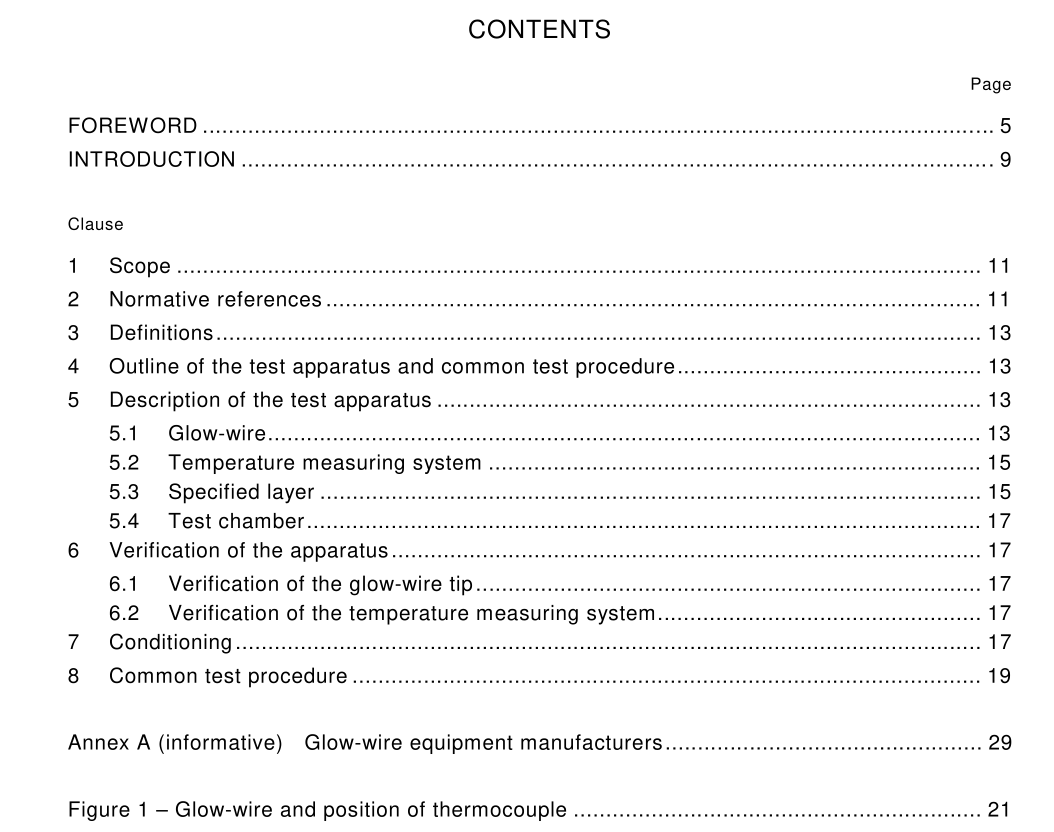IEC 60695-2-10 pdf download

IEC 60695-2-10 pdf download.Fire hazard testing
1 Scope
This part of IEC 60695 specifies the glow-wire apparatus and common test procedure to simulate the effect of thermal stresses which may be produced by heat sources such as glowing elements or overloaded resistors, for short periods, in order to assess the fire hazard by a simulation technique. The test described in this standard is applicable to electrotechnical equipment, its subassemblies and components, and may also be applied to solid electrical insulating materials or other solid combustible materials. One of the responsibilities of a technical committee is, wherever applicable, to make use of basic safety publications in the preparation of its publications.
2 Normative references
The following normative documents contain provisions which, through reference in this text, constitute provisions of this part of IEC 60695. For dated references, subsequent amendments to, or revisions of, any of these publications do not apply. However, parties to agreements based on this part of IEC 60695 are encouraged to investigate the possibility of applying the most recent editions of the normative documents indicated below. For undated references, the latest edition of the normative document referred to applies. Members of IEC and ISO maintain registers of currently valid International Standards. IEC 60584-1 :1 995, Thermocouples – Part 1 : Reference tables IEC 60584-2:1 982, Thermocouples – Part 2: Tolerances IEC 60695-2-1 1 :2000, Fire hazard testing – Part 2-1 1 : Glowing/hot-wire based test methods – Glow wire flammability test methods for end-products IEC 60695-2-1 2:2000, Fire hazard testing – Part 2-1 2: Glowing/hot-wire based test methods – Glow wire flammability test method for materials IEC 60695-2-1 3:2000, Fire hazard testing – Part 2-1 3: Glowing/hot-wire based test methods – Glow wire ignitability test method for materials ISO 4046:1 978, Paper, board, pulp and related terms – Vocabulary ISO/IEC 1 3943:2000, Fire safety – Vocabulary
4 Outline of the test apparatus and common test procedure
This part of IEC 60695 specifies the glow-wire apparatus and common test procedure as a fire test using a non-flame ignition source. The glow-wire is a specified loop of resistance wire, which is electrically heated to a specified temperature. The tip of the glow-wire is brought into contact with a test specimen for a specific period of time and a range of observations and measurements made, dependant upon the particular test procedure. A detailed description of each test procedure is given in IEC 60695-2-1 1 , IEC 60695-2-1 2 and IEC 60695-2-1 3.
5 Description of the test apparatus
5.1 Glow-wire The glow-wire is made from nickel/chromium (80/20) wire, with an overall nominal diameter of 4 mm. The wire is formed into a loop as detailed in figure 1 . The glow-wire is heated by a simple electric circuit as shown in figure 2. There shall be no feedback mechanism or circuit to maintain the temperature. Due to the high currents involved, it is essential that the electrical connections for the glow-wire are capable of carrying the current without affecting the performance or long-term stability of the circuit. NOTE 1 The typical current necessary for heating the tip to a temperature of 960 °C is between 1 20 A and 1 50 A. The test apparatus shall be so designed that the glow-wire is kept in a horizontal plane and that it applies a force of 1 ,0 N ± 0,2 N to the test specimen during the application of the glow-wire. The force shall be maintained at this value when the glow-wire or the test specimen is moved horizontally one towards the other. The penetration of the tip of the glow-wire into and through the test specimen shall be limited to 7 mm ± 0,5 mm.5.2 Temperature measuring system The temperature of the tip of the glow-wire shall be measured by a class 1 (see IEC 60584-2) mineral-insulated metal-sheathed fine-wire thermocouple with an insulated junction. It shall have an overall nominal diameter of 1 ,0 mm or 0,5 mm and wires of, for example, NiCr and NiAl (type K) (see IEC 60584-1 ) suitable for continuous operation at temperatures up to 960 °C with the welded point located inside the sheath as close to the tip as possible. The sheath shall consist of a metal resistant to continuous operation at a temperature of at least 1 050 °C. In case of dispute, the 0,5 mm thermocouple shall be used. NOTE 1 A sheath made from a nickel-based heat-resistant alloy will satisfy the above requirements. NOTE 2 It is the intention for a future revision of this standard that the reference to 0,5 mm thermocouples will be withdrawn. The glow-wire, with the thermocouple, is shown in figure 1 . The thermocouple is arranged in a pocket hole, drilled in behind the tip of the glow-wire, and maintained as a close fit as shown in detail Z of figure 1 . The thermal contact between the tip of the thermocouple and the end of the drilled hole shall be maintained. Care should be taken to ensure that the thermocouple is able to follow the dimensional changes of the tip of the glow-wire caused by heating. The instrument for measuring the thermovoltages may consist of any commercial digital thermometer with a built-in reference junction. NOTE 3 Other temperature-measuring instrumentation may be used, but, in case of dispute, the thermocouple method must be used.









